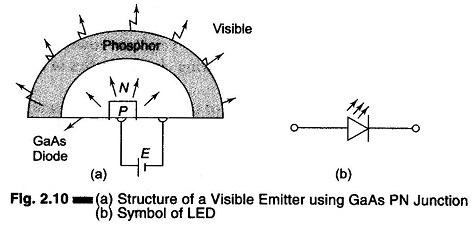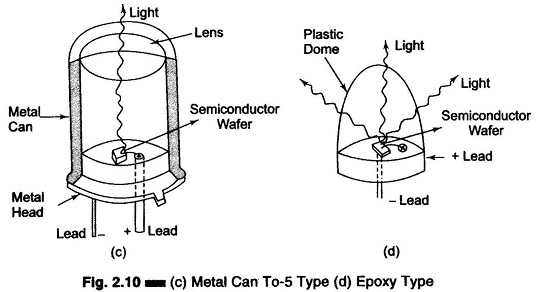What is the use of Light Emitting Diode (LED)?:
What is the use of Light Emitting Diode (LED)? – The Light Emitting Diodes, Fig. 2.10 (a) is basically a semiconductor PN junction diode capable of emitting electromagnetic radiation under forward conductions. The radiation emitted by LEDs can be either in the visible spectrum or in the infrared region, depending on the type of the semiconductor material used. Generally, infra-red emitting LED’s are coated with Phosphor so that, by the excitation of phosphor visible light can be produced. LEDs are useful for electronics display and instrumentation. Figure 2.10 (b) shows the symbol of an LED.
The advantage of using LEDs in electronic displays are as follows.
- Light Emitting Diodes are very small devices, and can be considered as point sources of They can therefore be stacked in a high-density matrix to serve as a numeric and alphanumeric display. (They can have a character density of several thousand per square metre).
- The light output from an LED is function of the current flowing through An LED can therefore, be smoothly controlled by varying the current. This is particularly useful for operating LED displays under different ambient lighting conditions.
- LEDs are highly efficient emitters of EM radiation. LEDs with light output of different colours, i.e. red, amber, green and yellow are commonly available.
- LEDs are very fast devices, having a turn ON-OFF time of less than 1 ns.
- The low supply voltage and current requirements of LEDs make them compatible with DTL and TTL, ICs.
In germanium and silicon semiconductors, most of the energy is released in the form of heat. In Gallium Phosphide (GaP) and Gallium Arsenide Phosphide (GaAsP) most of the emitted photons have their wavelengths in the visible regions, and therefore these semiconductors are used for the construction of LEDs. The colour of light emitted depends upon the semiconductor material and doping level.
Different materials used for doping give out different colours.
- Gallium Arsenide (GaAs) — red
- Gallium Arsenide Phosphide (GaAsP) — red or yellow
- Gallium Phosphide (GaP) — red or green
Alphanumeric displays using LEDs employ a number of square and oblong Light Emitting areas, arranged either as dotmatrix or segmented bar matrix. Alphanumeric LEDs are normally laid out on a single slice of semiconductor material, all the chips being enclosed in a package, similar to an IC, except that the packaging compound is transparent rather than opaque. Figure 2.10 (c) and (d) gives typical LED Packages for single element LEDs.

